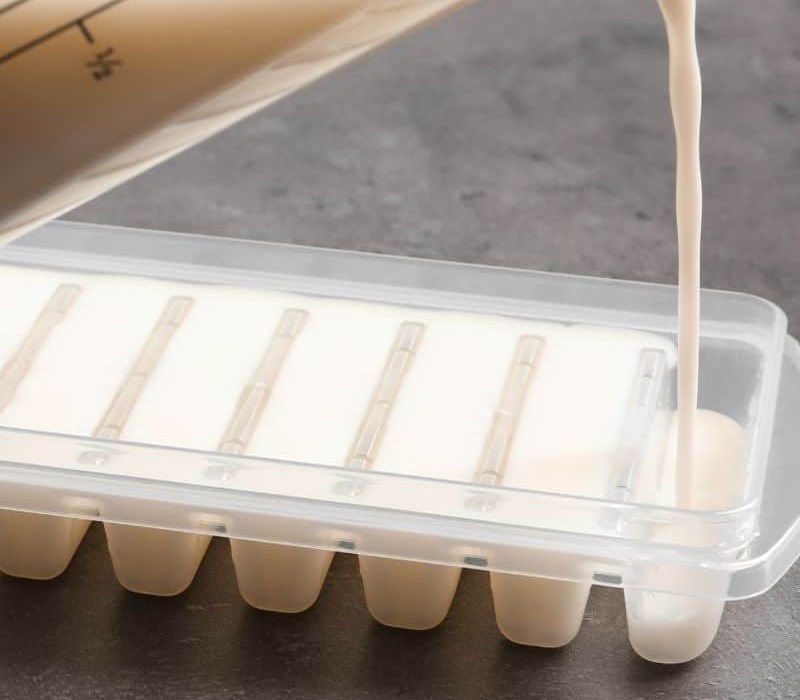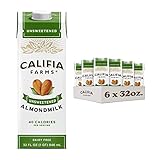Hey guys! If you’ve ever had a carton of almond milk leftover and worried about it going bad before you can finish it, you may have wondered, can you freeze almond milk? In short, yes you can! In this post, I will explain the best methods to freeze almond milk, how to defrost it, and how to use it!
Almond milk has become more and more popular in recent years. It is one of the most popular kinds of plant milk around and is used in a variety of recipes from adding it to your morning cereal, making a latte, creating a creamy smoothie, or even as a substitute for dairy in baked goods.
You may be a champion almond milk drinker, or you may only occasionally use it for your favorite smoothies. No matter what, you don’t want your almond milk to go bad in the fridge before you can use it all up. One way to extend the shelf life is to freeze it!
Page Contents
Can You Freeze Almond Milk?

In short, yes, you can freeze almond milk, but it’s not as simple as you might think. While it is completely safe to freeze almond milk, the challenge comes after it is defrosted. Almond milk separates after it’s been frozen, which also alters the flavor. You must always blend defrosted almond milk before using it.
But, you can use thawed almond milk in recipes and baked goods without too much of a challenge. But you never want to add thawed almond milk to your cereal, coffee, or smoothies.
In this post, I will explain how to freeze almond milk in two different ways, tips for freezing almond milk, the benefits and drawbacks, and how to use frozen almond milk.
How to Freeze Freeze Almond Milk?
While it is safe to freeze almond milk, most brands advise against it. This is because when the almond milk thaws after it’s been frozen it separates. The solids fall to the bottom while the liquids rise to the top. But that doesn’t mean you can’t do it successfully! Here’s how!
Using Ice Cube Trays
Using an ice cube tray is my favorite way to freeze almond milk. It is super convenient because you can pull as many cubes as you need for a recipe, without defrosting more than you need. I prefer a silicone ice tray with a lid so that the cubes easily pop out, and the liquid doesn’t spill all over my freezer before it’s had a chance to set.
Step 1: Pour your almond milk into the ice cube tray, and place the lid on top if you have one.
Step 2: Place the tray in the freezer for 2-3 hours or until set. Placing it in the freezer overnight is another good option.
Step 3: When the cubes are set, pop them out of the ice cube tray, and transfer them to a freezer bag. Label the bag with the date. This is important so that you don’t use expired almond milk cubes. You can also read more about Almond Milk Unsweetened | No Sugar, All Nut.
Using Containers
If you have a large amount of almond milk to freeze, freezing it in containers might be the best way to go. Choose freezer-safe airtight containers such as these 16-ounce plastic storage containers.
Step 1: Measure how much each container holds. For example, a 16-ounce container holds 2 cups.
Step 2: Pour the almond milk into the container.
Step 3: Label the containers with the date and contents. Place in the freezer overnight. You can get more from this video.
How to Defrost Freeze Almond Milk?

Depending on how quickly you need to defrost your almond milk, there are a few options.
Place in the Fridge Overnight: Place the amount of almond milk you need to defrost in the refrigerator. Overnight it will slowly defrost and return to liquid form. If you have a particularly large container, it may take longer than overnight for it to defrost.
Warm Water: If you need your almond milk defrosted more quickly, you can opt to submerge it in warm water. You can do this by placing the frozen container of almond milk into a larger bowl filled with lukewarm water.
Or if using cubes, place them in a baggie, submerge them into a bowl of warm water, or run them under the faucet until the milk has completely defrosted.
Defrost While Cooking: This is not my favorite option, because if you defrost the almond milk while you’re cooking you won’t have a chance to add it to your blender to combine, which can result in your recipe having a strange flavor or consistency.
Tips For Freezing Almond Milk
Before you decide which method to use for freezing consider your use for the almond milk after its defrosted. For example, if your primary purpose is to use your cubes in smoothies, then using an ice cube tray is likely the best option. However, if you plan to use almond milk for baking recipes, then using larger containers is likely the best way to go.
Always label your frozen almond milk with the date. It will keep for up to 6 months, but beyond that, you will want to discard it.
If freezing cubes for a recipe, measure the volume of each cube so you know how many cubes you need for a particular recipe.
After thawing, be sure to blend your almond milk to return it to a creamy texture. Place it in the blender for 20-30 seconds to combine the solids and the liquids.
Never drink defrosted almond milk straight! The taste will be a little off, and even if you blend it, you will not achieve the cream consistency and freshness of the original almond milk.
The first two options provide you with the opportunity to blend. While fresh almond milk does not need to be blended before use, defrosted almond milk does because the ingredients separate. A few shakes or a good stir can also help do the trick if you don’t have a blender.
Pros of Freeze Almond Milk

Ever let your almond milk go to waste!
Extend the shelf life.
Use in smoothies for a thick and creamy texture.
Use in cooking and baking recipes.
The nutritional value of this lactose-free milk remains the same.
Cons
Freezing and thawing almond milk results in a change in consistency and flavor.
Manufacturers advise again freezing almond milk because it will separate when defrosted. The image above shows how the solids fall to the bottom, and the liquid rises to the top.
Even blending defrosted almond milk will not return it to its original consistency or flavor. Below is a picture of fresh almond milk versus defrosted and blended almond milk. You’ll notice there’s not much of a difference in the color, but the defrosted almond milk has foam on the top and tastes slightly different.
How to Use Freeze Almond Milk?
Mix frozen almond milk cubes with regular almond milk, to give your smoothies an icy cold and thick texture.
Ice cream! Combine frozen bananas with frozen cubed almond milk to achieve a thicker ice cream consistency.
Conclusion
Please comment below if you found this article helpful for you or not. What is your opinion about this?
Frozen almond milk is great for as long as a half year. It won’t be terrible after that point, but, it will unquestionably have a less engaging surface. The sooner you can utilize your frozen almond milk the better.
No, I don’t suggest refreezing almond milk that has proactively been thawed out once. The freezing impacts of almond milk will just increment after you attempt to freeze it once more.
I don’t suggest freezing almond milk in the container. The container almond milk is bundled in isn’t cooler agreeable. You are greatly improved by freezing it in ice shape plates or cooler safe holders.







